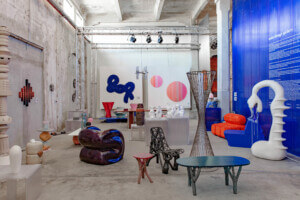Design showrooms often suffer from white cube syndrome. The “white cube”—as christened by Brian O’Doherty in a three-part Artforum essay in 1976—is an environment in which a curator or gallerist presents objects, generally art, against a backdrop of featureless white walls. In this type of space, it’s believed, viewers can appreciate the items on their own formal terms, without the distractions of color, decoration, or expressive architecture.
But the white cube poses challenges for works of design, which by their very nature demand interaction and context (and, in most cases, inspire hopes that they will be sold). In a design showroom, the hallmarks of white cube syndrome are Danish stools set on eye-level platforms, conceptual clusters of pendant lighting, and the worst offender: the chair wall.
Fortunately, a cohort of designers, gallerists, and manufacturers is taking a new approach to showrooms, transforming them into distinct, character-driven spaces. Some are even embracing the possibilities of digital interiors, creating showcases that are accessible from anywhere in the world.
One of these reformers is Susan Clark, who founded her New York City-based company, Radnor, in 2016 after years of working for collectible design platforms such as The Future Perfect. Eschewing the storefront model, Clark sets up entire apartments as showrooms for her line of furnishings and accessories, called Radnor Made, as well as pieces by the designers she represents.











